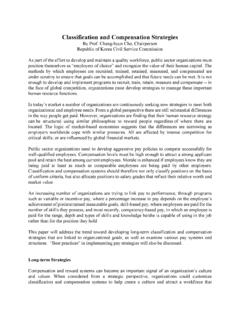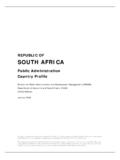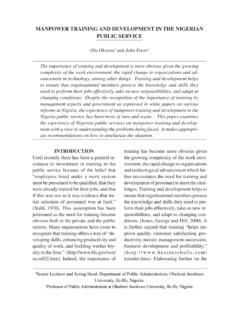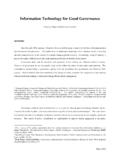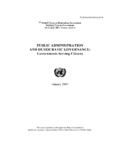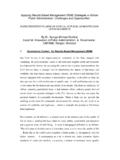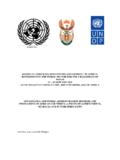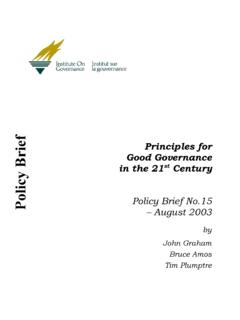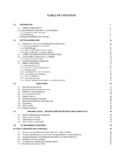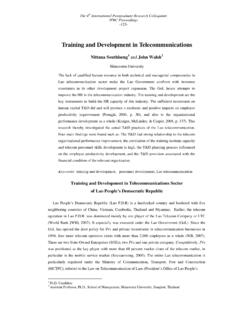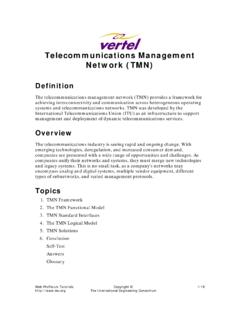Transcription of Improving the Efficiency of the Public Sector: A Case ...
1 UNITED. NATIONS ST. Secretariat Distr. LIMITED. ST/ 5 July 1995. ENGLISH ONLY. Twelfth Meeting of Experts on the United Nations Programme in Public Administration and Finance New York, 31 July-11 August 1995. Improving THE Efficiency OF THE Public sector : A CASE-STUDY OF MALAYSIA. CONTENTS. Paragraphs Page INTRODUCTION .. 1 - 2 2. sector REFORMS .. 3 - 55 2.. 56 - 61 15. ST/ English Page 2. * Prepared by Muhammad Rais Bin Abdul Karim, consultant to the Department for Development Support and Management Services of the United Nations Secretariat. The views expressed are those of the author and do not necessarily reflect those of the United Nations. 95-19174 (E) 170795 /.
2 *9519174*. /.. ST/ English Page 3. INTRODUCTION. 1. A shining example of a success story in economic transformation, Malaysia is a country that has sought and achieved economic development while maintaining its traditional culture and values, and it has judiciously adapted the civil service to support its national objectives. 2. Since independence in 1957, Public sector reform has been a part of the Government's agenda. In the 1980s reform revolved around the need to improve the quality of Public sector management and to shift the responsibility for economic development to the private sector . To improve the quality of service offered by Public sector agencies to clients at the "service" counter, the Government took several measures to improve existing procedures and systems, introduced office automation and information technology to strengthen information and service delivery, and enhanced the capacity of district administration.
3 Realizing that values and ethics are critical for the provision of "quality" service, the Government launched several programmes to inculcate desirable values, such as honesty, discipline, integrity, dedication, accountability, trustworthiness and Efficiency among the Public servants. The administrative reforms of the nineties were guided by the underlying philosophy of quality, with emphasis on administrative improvements, enhancement of information technology, improvement of information, and service delivery. I. Public sector REFORMS. 3. Since independence, the Malaysian Public service has been entrusted with the twin task of socio-economic development and nation-building.
4 To ensure success a series of administrative reforms or modernization efforts in the Public service were undertaken. 4. Each reform effort can be seen as a product of environmental factors (particularly economic conditions and societal demands) and the developmental policies and objectives of the Government. The administrative reforms introduced since independence can be classified into the following focus areas, namely: (a) Structural changes;. (b) Improved productivity and delivery of services;. (c) Office automation and information systems technology for the Public sector ;. (d) Measuring Efficiency and effectiveness;. (e) Improving performance reporting in the Public sector .
5 /.. ST/ English Page 4. (f) Total quality management;. (g) Attitude and behavioural changes;. (h) Strengthening statistical capacity;. (i) District administration. Structural changes 5. Upon independence, the Government inherited the administrative machinery left by the British. The primary orientation of the colonial bureaucracy was towards the maintenance of law and order, revenue-collection and a restricted developmental role. Known as the maintenance administration phase, it covered the pre- and post-independence period (1950s and 1960s). 6. The major impetus for change, however, was provided by the Esman-Montgomery report to the Malaysian Government of 1966, which recommended major changes in Public administration, education and training.
6 The report represented a milestone in Malaysian administrative reforms because it led to a change in approach and philosophy that resulted in a shift from maintenance administration to development administration. The primary message of the report was that the administrative system must focus on change and that civil servants must become the key agents of change. The primary role envisaged for the Public sector was the promotion of development and institution building. 7. The Malaysian economy was characterized by high growth in the 1960s, and the Government's plan to provide a wider range of goods and services to the populace required the creation of new institutions and the streamlining of others.
7 The creation of new organizational structures as instruments of development must be seen as a major reform effort, albeit at a structural level, to provide new and expanded services. With the formation of Malaysia in 1963, the focus on institution building and development administration became even more fervent as the Government embarked on more development projects to ensure the success of the new political entity. 8. There was a need for a civil service that could deliver more effectively and efficiently the new and expanded services and implement socio-economic development programmes. Based on the recommendation of the Esman-Montgomery report, the Government established the Development Administration Unit (DAU).
8 Within the Prime Minister's department to reorient the Public sector in its operational style and thinking - and to focus on development rather than solely on maintenance functions. The Unit was established as a centre for reform efforts and was charged with identifying and implementing administrative improvements in the Public service. Since its establishment, the Unit has conducted a number of important studies on organizational structures, processes and procedures and has made a series of recommendations to bring about administrative changes in the Public service. /.. ST/ English Page 5. 9. A renewed sense of purpose and urgency followed the introduction of the New Economic Policy in 1971.
9 New institutions, primarily Public enterprises, were established as the developmental role of the Government was expanded even further in the face of a weak private sector , and high premium was placed on training and upgrading the skills as well as the knowledge of civil servants to augment their developmental roles. The study by the Development Administration Unit on training needs in the Public service and its recommendation for short- term and long-term plans for upgrading training facilities in the civil service led to the establishment of the National Training Institute in 1972. This resulted in a large number of Public sector employees being trained at the Institute in the area of development administration.
10 10. Major initiatives in the areas of personnel management were also recommended in the Esman-Montgomery report. In the area of Public personnel management, there was a review of the recruitment, promotion, discipline and personnel evaluation policies and practices. This resulted in the reorganization of the Federal Establishment Office in 1970 to form the Public Service Department (PSD) as a separate institution. As a central personnel agency, it was entrusted with the responsibility for initiating and implementing personnel management policies that would increase the Efficiency and effectiveness of the Public service. The Department also had a Training and Career Development Division.
